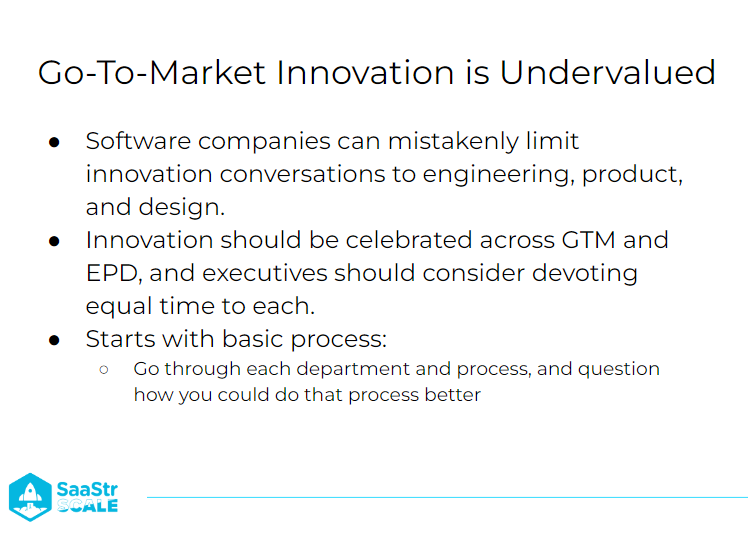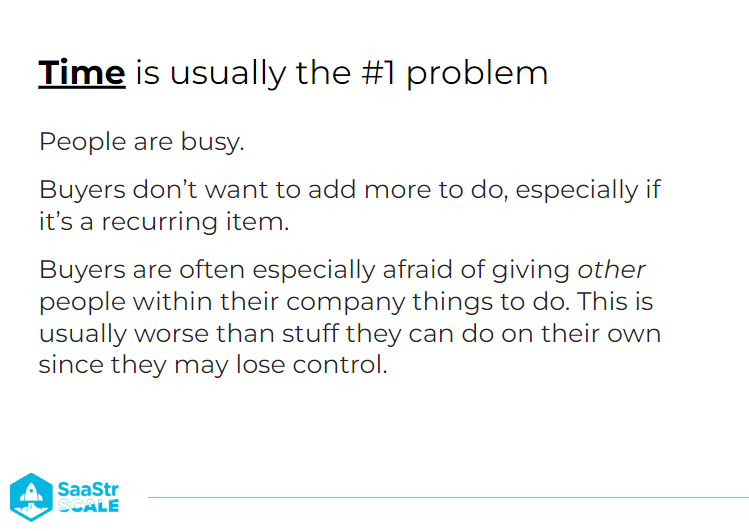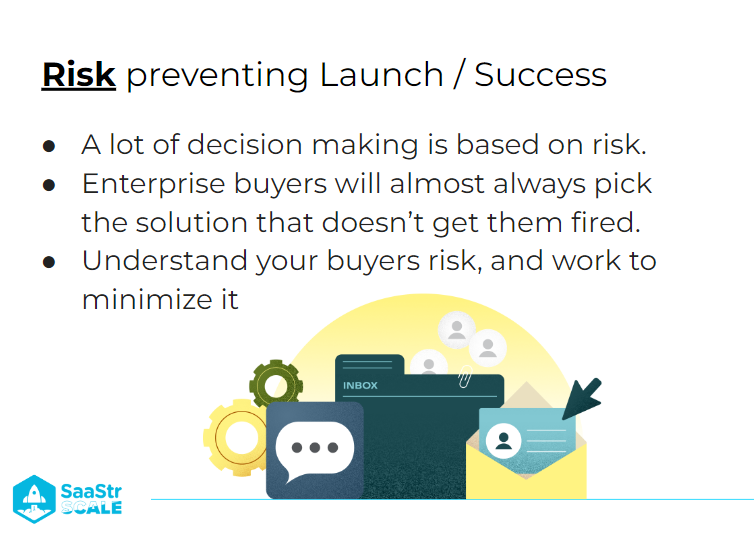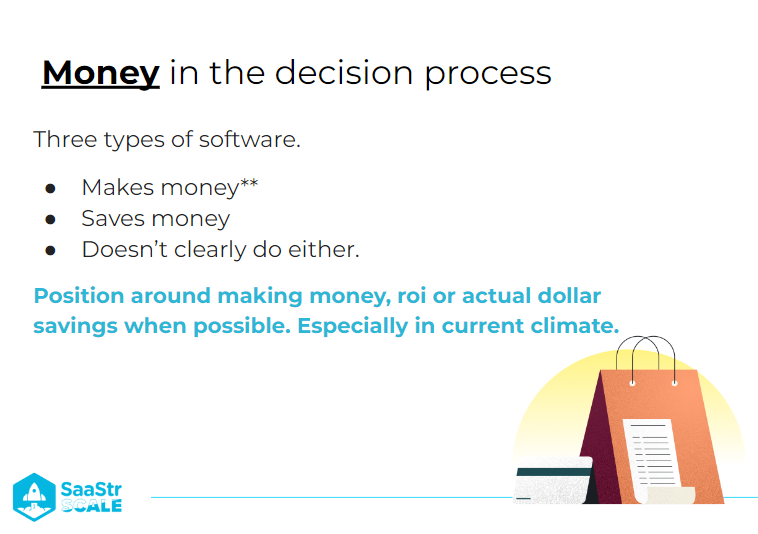On any given day, the enterprise buyer has many priorities that will come before your product, and those priorities may not be what you expect. How do you ensure your solution gets implemented and retained?
In this session, Attentive Co-founder & CEO Brian Long walks through some of the lessons learned at Attentive on their path to over 5,000 customers in 5 years. He’ll dig into real-world examples for reducing friction in sales, product, and customer success.
“Go-to-market innovation today is significantly undervalued.”
When a lot of companies talk about innovation today, they often immediately jump to what that means for engineering and product. However, you should spend a similar amount of time on how you can innovate in your go-to-market team. Of course, product innovation is very important, but we often forget how important going to market innovation is. If you make innovations there, it can compound very quickly and come back into the product and help you grow a lot.
At Attentive, Long goes through every department and each one of the processes they do on a regular basis, and asks the question, “Should we be doing this process differently? Are we doing it the best way we could?”

You might have had it right a year ago or two years ago, but maybe something has changed or someone on the team found something really cool they’re using now, and you should roll that out to everyone.
There are a lot of opportunities to be found in tinkering and innovating on your GTM side that you may not have thought about before with regard to how to smooth the sales funnel. Don’t forget that your sales funnel is not only presale, but post-sale, as well, with your customer service and your customer success team.
When Long considers what stops a buyer, what are the key friction points within the sales funnel, he simplifies that down into three buckets.

Time
Although money is the first thing most people think of, Long believes the investment the buyer will have to make to set up and use your product is actually the number one consideration when purchasing new software. People are often very busy and don’t want to add more things that they have to do. They don’t want to add more workflows, especially if it’s something recurring that they’re going to have to do all of the time.
Buyers are also often very worried about the time that they will need for other resources within the company, particularly if they don’t control those resources. That’s something that is going to make them unpopular. It’s going to make them unable to deliver and use maybe the software that they’re buying. So you really have to think about the time that your buyer spends, but also how that time is spread across the org and whether or not they control those areas of time across the organization.
Long breaks that time down into three different buckets.
- The first bucket is decision time. Who is making the decision on using your product and how much time will it take for them to make that decision?
- Number two is integration time. How long does it take to actually set up your product and launch the product? What sort of resources does that need?
- Number three is maintenance time. Once that product is up and off the ground and flying, what does it take to continuously service and use this product?
If you do all this analysis and you figure out that your product doesn’t need a lot of time, that’s great! Immediately make that front and center in your pitch. Many businesses that have a low time need aren’t doing a good job conveying that in their messaging.
However, the majority of software does have a significant time need. So when you look at that, you need to think about every way that the buyer is spending that time and how can you remove that burden from the buyer in spending that time to make it easier for them to say yes and to want to jump in?
For example, Attentive builds text message-based marketing communication tools for over 5000 different brands. The goal is to drive a lot of revenue for each one of these brands. In order to get started with Attentive, in the beginning, would take about 30 to 60 days. This was leading to a lot of meetings, a lot of resources, both at Attentive company and across the customer’s company: engineering, design, marketing, finance, a lot of people and assets needed to get off the ground. And then on an ongoing basis, there was a lot of maintenance.
So it was a significant amount of time to get the product off the ground. They spent a lot of time thinking about how do we make this a lot easier? So instead of relying on the customer to kind of do all of their get started process and do everything themselves, Attentive built a team that would step in and do all the work for the customer that they needed in order to get started. If you can get to a place where the customer just has to approve things rather than having to continuously add in data or copy and think about it, it’s going to go a lot smoother because people ultimately want to approve it.
The steps that your team takes are going to be more in line with the stuff that works for your product, and that ultimately will lead to higher retention and more happy customers.

Risk
Number two is risk. What sort of perceived risk is the buyer taking by choosing to use your service?
At mid-market to large companies, the enterprise buyer is almost always going to pick the solution that doesn’t get them fired. So it’s very important that you understand the risk that buyers are taking by selecting your solution and help them to not feel concerned when picking your solution.
At Attentive, they helped alleviate the risk of SMS sign-ups cannibalizing a company’s email list by offering a sign-up that allowed consumers to sign up for both lists on one form.
SMS is a highly-regulated field and Attentive found that there were a lot of brands, particularly larger brands, very worried about this. So they built out a legal team and then that legal team helped to build products specific to compliance. And those products have shielded their customers from the tremendous legal risk that no longer exists and this has now become a major differentiator for their product.
Money
There are three types of software companies: software that makes money, software that saves money, and software that you’re not really sure what it does.
In the economy that we’re moving into right now, you’re going to see a lot of movement toward software that makes money and saves money. And you’re going to see people pulling back on stuff that they’re not sure what it does. So, you need to find a way to position your products as clearly as possible on how it makes or saves money, or the problem you solve needs to be massive.
In most cases today, you really are going to see companies gravitate towards the make money and save money buckets. And you need to find a way to associate your solution with one of those two buckets to be successful.

Free trials are popular in SaaS, but early on, Long was advised that you don’t need to give free trials to larger companies because they’re public and they don’t want to do free trials. They want to sign big commitments. They want to sign big contracts. They don’t like to try things out.
However, Attentive found that not to be the case at all. They found that big companies often have the same level of appreciation for free trials as medium or small companies. In many cases, trials helped to sign very significant customers that didn’t have the dollars initially in order to do a one-month or two-month proof of concept.
Attentive also learned that starting small in large companies can lead to much bigger deals. People can feel a lot of trepidation when they see a very big sticker price. Long says finding a way to have lower sticker prices, but that just grow over time is a much better strategy, even across different customer sizes. He says it’s a fallacy that big companies have big money all the time to spend.
Big decisions can also slow deals down or stop them completely. You go through a sales process and you have a very big contract and you need to get to a company to make a very big decision point. You may close one in five of those. It’s much better if you can break down those big decisions into several much smaller decisions. Those decisions sort of compound and snowball, as you grow and you’re going to have much higher close rates, than one big go or no-go decision that can lead to inaction on the side of the buyer.
Finally, you need to be comfortable charging more as you add more value. That also means the price is in line with your value, particularly where your customer might be in their lifecycle.
Key Takeaways
- Time is often the thing that people do not give nearly enough credit for, but it’s extremely important for how the buyer makes their decision. And you need to figure out what sort of time your product requires in order for them to say yes.
- Almost all products come with some component of risk with saying yes and trying out that product. And you want to minimize that risk as much as possible. You want to understand that risk and then work in your product to build against that risk so that it makes it much, much easier for that buyer to say yes.
- Be creative and really embrace that Go-to-market innovation to be creative about what you’re ultimately doing so that you can set a nice customer flow and have very, very smooth onboarding.
The post Removing Friction: How to Turn More Than 40% of Your Prospects Into Long Term Enterprise Customers with Attentive Co-founder and CEO Brian Long (Pod 623 + Video) appeared first on SaaStr.
via https://www.aiupnow.com
Amanda Beaty, Khareem Sudlow
